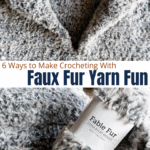6 Tips for Working and Crocheting With Faux Fur Yarn
This post may contain affiliate links, meaning that I may earn a small commission if you make a purchase. See our disclosure policy for more information.
Have you ever struggled to crochet with fur yarn? When working with faux fur yarn it can be difficult to see your stitches, to count your stitches, and to count your rows, but these tips are sure to help!

6 Tips for Working With Faux Fur Yarn
When I posted a teaser photo on Facebook of my new Men’s Quarter Zip Sherpa pattern, I wasn’t too surprised to see comments mentioning how it must have been “difficult to work with” this yarn, or “hard to see your stitches”, etc. After working up an entire men’s size pullover using Fable Fur, I thought I’d share with you things that helped me while working with this lush fur yarn. The experience doesn’t have to be a horrible one!

There are many different brands of faux fur yarn. Each brand varies in thickness, composition, and the means of manufacturing. Today we are looking at Fable Fur from Knit Picks and WeCrochet. Regardless of the brand used, these tips for working with faux fur yarn are sure to help!
1. Count each stitch as you make it.
Fur yarn works up beautifully, but it is 100% a pain to count your stitches. Instead of trying to count at the end of each row, count each stitch as you crochet it. Yes, every single one. This is especially helpful when increasing or decreasing.

2. Crochet fur by feel.
Because faux fur stitches can be difficult to see (let alone the individual loops of a single stitch) it is easier to crochet by feel. If you need to count your stitches at the end of a row, it helps to feel the stitches instead of trying to see them. Similar to counting beads on a rosary, for example.

3. Use a tally mark system.
Not only does it help to count each stitch as you make it, it also helps to have a tally mark system in place for keeping track of your rows. Counting rows made with fur is just as difficult (or more so) than counting stitches made with fur. Save yourself the heartache and mark each row off as you make it.
Caution! Stay as consistent as possible when recording your tally marks. Always record the row either as you start it OR as you finish it, but choose one way and stick with it. You don’t want to mark some rows at the beginning of the row and others at the end because then you’ll forget which you did where and poof! All that careful counting goes right out the window.

4. Ball your faux fur yarn before you use it.
There is nothing worse than crocheting along, finding a knot, and having to cut it out before continuing on. Because of the way yarn is made (including acrylic AND fur), knots are inevitable. Fur yarn does tend to have more knots than acrylic, however, and you will thank yourself if you ball your yarn before using it.

You can see here that by balling several skeins of the fur at once, I am able to quickly see which balls are the biggest, and grab those first.
Tip! When starting a new ball of yarn, use needle and thread to literally (and securely) sew the two ends together, like so:

Wanna save this for later?
I am using red thread here for view-ability, normally I would have chosen black thread. There is enough of the fabric backing (on Fable Fur at least) to give you enough material to work with, and it will not be detectable at all.

This means that not only do you have fewer ends to weave in (as in NONE!) you waste less yarn as well!

If, when finished, you still have smaller balls left over at the end of your project, consider using that yarn for stuffing in a future project! Waste not, want not.
5. Always turn each row, even when working in the round.
By consistently turning at the beginning (or end) of each row, it is easier to find the first stitch of the row. This happens because turning leaves a more noticeable bump for the first stitch, instead of just chaining to start your row and continuing on. This helps to make it more obvious where the first stitch is, so that you can slip stitch to it easier when working in the round (or to count your stitches if needed).

6. Leave longer tails to weave in.
By leaving longer tails, you are giving yourself just the few extra inches needed to really weave in those fur ends. Fur is silky and can be slippery, so make sure your ends are super secure. Weave in those puppies well!
Are there other tips I missed? If so, please let me know in the comments so I can get that added. I can’t wait to share my new sherpa pattern with you soon!

Stay tuned for the Men’s Quarter Zip Sherpa pattern! If you liked this, I think you’ll love these:
3 Reasons to Use Pantyhose in Crochet
How Much Yarn Do I Need? How to Determine Yardage in Crochet
Linked Double Crochet Stitch Tutorial







